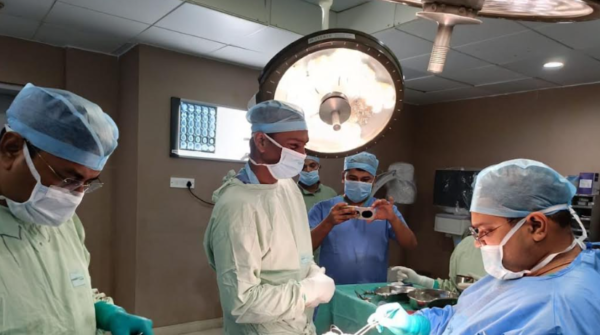Mumbai / Kolkata, April 29, 2025 – At an age when most people are expected to slow down, an 85–year–old man has redefined what it means to fight for life. Frail in appearance but strong in spirit, the long-term dialysis patient arrived at Manipal Hospitals, Dhakuria, unconscious and battling an acute brain haemorrhage—his survival chances slim. Yet today, he is awake, speaking, and standing with support, preparing to return home. His story is a powerful testament to modern medicine, multidisciplinary teamwork, and the unyielding will to live, proving that age, however advanced, is no longer a limit to recovery.

A known hypertensive with prior cardiac stenting and chronic kidney disease (stage 5 dialysis–dependent), and a history of seizure-related hospitalizations, the patient had already weathered numerous health storms. His condition took a sudden and alarming turn when he lost consciousness at home. On arrival, doctors noted that one of his pupils was dilated — an ominous sign — prompting immediate action.
Upon arrival at the hospital, a CT scan revealed a massive acute subdural haemorrhage—an internal brain bleed that had plunged him into a coma. Given his critical condition, compounded by chronic kidney disease requiring regular dialysis and the use of antiplatelet medication, which is known to significantly heighten bleeding risks, the outlook was bleak. Nevertheless, after extensive discussions with the family, the medical team decided to fight for his life.
Led by Dr. Nirup Datta, Consultant – Neurosurgery, high-risk, two-hour decompressive craniotomy was performed the same day under the observance of Dr. Ritesh Kauntia, Consultant, Nephrology, Transplant Physician, and Dr. Prakhar Gyanesh, Consultant, Anaesthesiology.
“The surgery was a race against time,” said Dr. Nirup Datta, Consultant – Neurosurgery, Manipal Hospital, Dhakuria, who led the neurosurgical team. “There were so many variables stacked against him. Given his advanced age, chronic kidney disease, dual antiplatelet therapy, and poor neurological status, the surgery carried extreme risks. However, we believed he deserved a fighting chance, so we gave it everything. Luckily, the patient’s family also supported our decision after we explained the risks to them. We removed a large clot and preserved the bone flap in his abdomen for future replacement.”
The days following surgery were fraught with complications. The patient developed a serious infection and went into septic shock, requiring intensive critical care, close renal monitoring, and advanced antibiotic support. A tracheostomy was considered but ultimately avoided, thanks to his gradual improvement and successful early extubation—a crucial milestone in reducing recovery time and complications.
Dr. Ritesh Kauntia, Consultant – Nephrology, Transplant Physician, Manipal Hospital, Dhakuria stated, “Managing dialysis in such a critically ill patient was extremely challenging. His kidneys needed ongoing support, even as his body fought the infection and trauma. Close coordination between the neurology, nephrology, and critical care teams ensured continuity of care at every step. Despite the odds, the patient slowly began to show signs of progress—first regaining consciousness, then following simple commands, and later attempting to speak. With sustained physiotherapy and medical support, he regained enough strength to sit up and stand with assistance.”
Dr. Prakhar Gyanesh, Consultant, Anaesthesiology, stated, “Because of his chronic kidney disease and dialysis dependency, we could only administer about a third of the usual medications safely. Managing this delicate balance between treating his brain injury and protecting his kidneys was immensely challenging — but essential. Despite all limitations, his spirit pulled him through.”
Despite his frailty and high risk of re-bleeding (due to antiplatelet medications), the patient recovered enough to stand with support and breathe spontaneously without assistance. He was discharged after 14 days with a structured homecare plan: ongoing dialysis thrice weekly, regular physiotherapy, and scheduled follow-ups. A second surgery to replace the bone flap is planned after two months, once his condition stabilizes further. This extraordinary case stands as a beacon of hope for families of elderly patients, showcasing that even the most fragile lives can bounce back with the right care.
